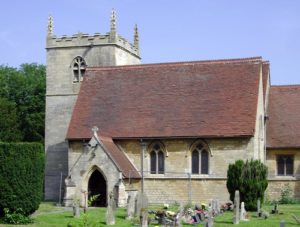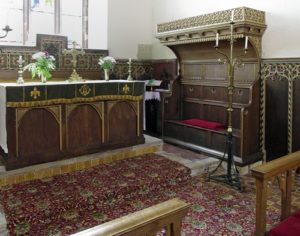Coddington is a neat and well kept village just off the A17 to the east of Newark. There is a air of wealth to both the village and the church.
This is thought to have been a site of Christian worship since Saxon times. A stone church was built in the 13/14thC and was in a very poor state of repair in the mid 19thC. It was demolished apart from the tower and completely rebuilt by G F Bodley in 1865 and decorated by William Morris and Burne-Jones.
It is set in its churchyard with a row of neatly trimmed yew trees leading up to the south porch. The low square tower with pinnacles at the corners is almost dwarfed by the steep pitched roof of the side aisles and nave. The chancel is nearly as long as the nave but is lower and has a small stone cross at the east end. There is a small and plain priest’s door on the south side of the chancel.
Inside the church, hexagonal pillars on the north side and round pillars on the south both with pointed arches separate nave and side aisles. Look carefully at the north pillars for the two small carved owls below the arch.
The nave is simple with quarry tiles, whitewashed walls, beamed ceiling and wooden pews. Your eye is drawn to the beautiful rood screen picked out with gilt paint which separates nave and chancel. This has panels along the base and decorative gilt frieze along the top. On either side are two panels with carvings of a bishop set under a gilt arch. Don’t do what I did. I stepped back to admire the figures on the left hand side. Space was a bit tight with the pulpit and I leant against the front of the first pew. To my horror this wasn’t firmly attached to the floor and it and I ended up on our backs. Fortunately no damage was done to either of us, just my dignity. Apparently it has never been attached and the parishioners don’t use that pew.
The chancel is much more elaborate and Morris gave reign to his artistic streak here. The floor is covered with patterned encaustic tiles. The ceiling has dark panels with a gilt P set in a pale grey roundel. Along the bottom is a Latin inscription. The organ is on the north wall and the base of the south wall is panelled. The panelling on the east wall is more elaborate with a gilt ogee arch and roundels along the top. Beneath the east window is a small reredos with three panels on either side with a sunburst design and a cross on a dark green background in the centre.
The free standing altar has three wood panels on the front with gilt decoration at the corners. On the south wall is a wooden settle with a carved and gilded canopy serving as a sedilia.
The east window by Morris and Burne-Jones has an image of the crucifixion in the centre with the Virgin Mary and St John. Below is a small image of the Annunciation. On the left are St Peter at the top with the keys, St Stephen and then Mary Magdalene at the bottom. On the right are St Paul with book and sword at the top, St James the Great and Martha at the bottom.
On the south wall of the chancel is another Morris window featuring St Cecilia with a harp and St Catherine with a book and sword.
There is a small altar in the south aisle. Above is another Morris window with a beautiful image of the Virgin Mary in the centre with a halo and wearing a vivid blue dress and holding a lily. On her left is Joseph in a red robe and holding a staff. On her right is St John, again dressed in red and holding a book and communion goblet.
Beneath the tower is a small stone font on four legs. On the west wall is a tiny Morris window with John the Baptist.
At the back of the nave is an elaborate wall memorial to John Somerled Thorpe MC, Captain of the Scots Guards who was killed on the Somme in 1916. It lists his battles and at the bottom are his three silvered medals.
I had expected great things of this church. Opening times are quite restricted to Wednesdays in Summer from 9-2 and the first Saturday of the month, although you can phone and ask for the church to be opened. We visited as part of the Nottingham Churches Open Weekend.
The church, especially the nave felt small and congested. There was little space. It was also the day of the Summer fete so there were stalls set up in the south aisle and as well as the second hand book stall along the back of the church. I can tick the box saying I’ve visited, but unlike many other churches, this isn’t one on my list of places to revisit.
Apart from the Bodley, Morris and Burne Jones connections, the church is also important (or notorious) for Constance Penswick Smith 1878-1938, daughter of the Vicar and who is buried in the churchyard. She was responsible for the revival of Mothering Sunday in the early 20thC, reintroducing it from the United States after the custom had died out in Britain.









